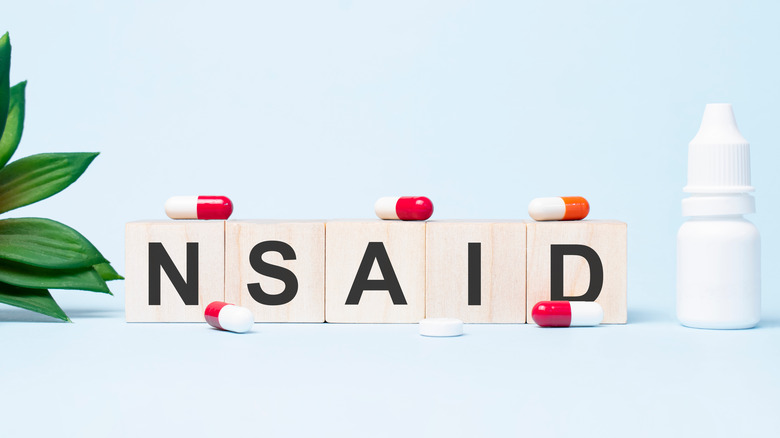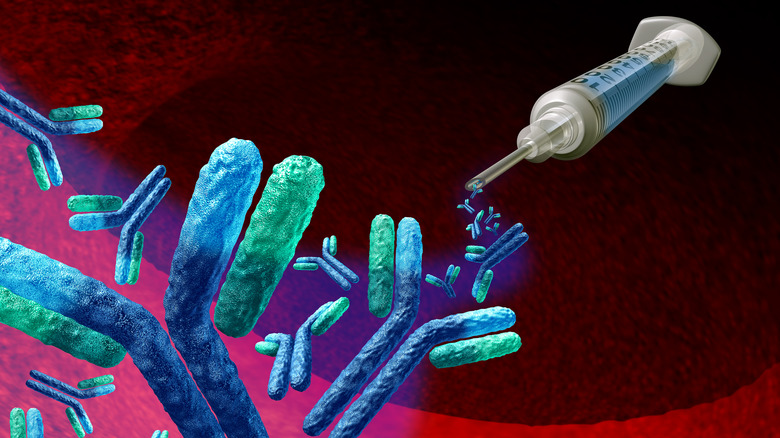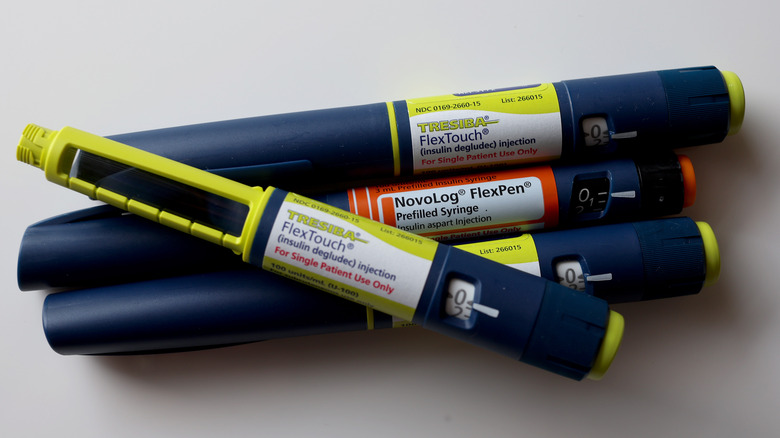12 Common Medications That Can Cause An Allergic Reaction
Medications have been around for over 4,000 years. Beginning in China, where hundreds of plants were used to treat a myriad of illnesses, medications have since evolved to what we know them to be now. Interestingly, certain medicinal plants from ancient times (e.g., camphor, senna, aloe, opium) continue to be used today in some form or another (via Proclinical). Nowadays, drugs come in different types of formulations, including tablets, capsules, syrups, injections, and ointments. They can be taken or used for both acute and chronic health conditions. However, while their main purpose is to help manage your illness and make you feel better, they are not without risks.
Various kinds of medicine can interact with one another, as well as with certain food and beverages. These interactions can sometimes be beneficial, but often, they are not. Additionally, some people may be more sensitive to certain drugs compared to others. They can even have allergic reactions to the drug itself or any of its ingredients. Drug allergy symptoms can vary from person to person; the most common ones include itching and skin rash. Some people may also develop hives, noisy breathing, bleeding, and swelling of the lips, tongue, or face. A severe and life-threatening form of allergic reaction called anaphylaxis can also happen, where a person can experience confusion, dizziness, difficulty breathing, rapid heartbeat, palpitations, severe abdominal pain, nausea, vomiting, and diarrhea (per Penn Medicine).
Below is a list of the most common drugs that may cause allergic reactions.
Penicillin and penicillin-related antibiotics
Out of all of the drugs discovered throughout history, penicillin is perhaps one of the most important ones. According to the New World Encyclopedia, over 200 million lives have been saved by penicillin since its discovery, and this number will continue to grow for as long as penicillin remains effective in treating bacterial infections.
It was Sir Alexander Fleming who made this incredible, albeit accidental, discovery: He was culturing some staphylococcus when he noticed that one of his plates had become contaminated with mold. The mold was penicillium, and oddly enough, the area close to where it was located did not show any bacterial growth. Word got out of his findings, and after several years of experiments, a team of scientists was finally able to purify penicillin, and infectious diseases that were once equivalent to a death sentence had now become easily treatable.
Examples of penicillin and penicillin-related drugs include ampicillin, amoxicillin, amoxicillin-clavulanate (Augmentin), and cephalosporins (e.g., cephalexin, ceftriaxone). According to Harvard Health, if you are allergic to penicillin, you should be thoroughly evaluated by a health professional to determine if it is a true allergy or not. Penicillin allergy likely will not last your whole life. But if you indicate that you are allergic to penicillin, you will be given a broad antibiotic instead, which can increase your risk of acquiring serious infections like Clostridioides difficile and methicillin-resistant Staphylococcus aureus.
Medications containing sulfonamides
The invention of sulfonamides occurred around the same time as penicillin. The Science History Institute recounts the story of Gerhard Domagk, a German soldier and doctor who created this substance using a chemical method that was used to help dyes stick better to wool. Domagk and his team tested it on mice and found that it was effective against Streptococcus pyogenes, the bacteria that causes strep throat.
Sulfonamides continue to be an essential part of several types of medications, including antibiotics (e.g., Bactrim, Eryzole), anti-diabetes drugs (e.g., Diabeta), sulfasalazine, dapsone, sumatriptan, celecoxib, and hydrochlorothiazide. Unfortunately, about 3% of people who take these drugs will have some form of allergic reaction to them. Aside from skin rashes and anaphylaxis, people who are allergic to sulfa-containing medications may also rarely develop Stevens-Johnson syndrome, leading to painful blisters on the skin, eyes, mouth, throat, and genitals. This deadly condition is very painful, requiring an immediate visit to the emergency room (per Healthline).
An important distinction needs to be made between sulfa and sulfites. Their similar-sounding names can make it easy to confuse one for the other, but WebMD explains that sulfa is used as a component in certain medications, while sulfites are mostly used to preserve food, beverages, and medications. Although both can cause allergic reactions, they are chemically distinct, which means that a sulfa allergy and a sulfite allergy are completely different from one another. Allergy to sulfite is commonly seen in people with asthma, and may trigger symptoms.
Nonsteroidal anti-inflammatory drugs
Most of us have probably taken a nonsteroidal anti-inflammatory drug (NSAID) at some point in our lives. After all, a lot of them can easily be bought without a prescription. Some of the most common over-the-counter NSAIDs include aspirin, ibuprofen (e.g., Advil, Midol, Motrin), and naproxen (e.g., Aleve). Prescription NSAIDs also exist, and they are usually more potent than the over-the-counter ones. These include diclofenac, indomethacin, ketorolac, and meloxicam.
According to Medical News Today, as a group, NSAIDs are able to decrease inflammation, reduce fevers, relieve pain, and prevent blood clot formation. They are usually used only for a short period of time, since prolonged NSAID use can lead to unwanted effects on the body like stomach ulcers and bleeding within the gastrointestinal tract.
If you have had a previous allergic reaction to any NSAID in the past, it is important that you review the drug contents of over-the-counter medications before taking them. You should also let your doctor know which NSAID you had a reaction to, and what kind of reaction you experienced. According to the U.S. Pharmacist, there are five different types of NSAID-induced hypersensitivity reactions (NHRs), and some of them may not even technically be an allergic reaction at all. In addition, symptoms of allergic and nonallergic types of NHRs can closely mimic each other. Your doctor can help you determine if you have a true NSAID allergy or not, and find out which ones will be safe for you to use.
Anti-seizure medications
Medications used to treat seizures are also known as anticonvulsants or anti-epileptic drugs. There are many different types, with each of them working via several unique mechanisms. Examples of these drugs include phenytoin, valproic acid, gabapentin, and benzodiazepines (e.g., diazepam, lorazepam). While all anticonvulsants are able to treat or manage seizures, some of them are also commonly used off-label for other health problems like anxiety, migraines, nerve pain, weight loss, Parkinson's disease, and mood instability (via StatPearls).
Based on a 2017 article published in Clinical and Molecular Allergy, anticonvulsant hypersensitivity syndrome (AHS) is a condition that can occur in certain people after taking aromatic anti-seizure medications like carbamazepine, lamotrigine, and phenytoin. It is a widespread disease that can cause fever, malaise, rash, and organ damage. Although it is rare (1 in every 1,000 to 10,000 exposures), it is estimated that death can occur in around 10% to 30% of people who develop this condition. Unlike a typical allergic reaction where rashes and itching can occur within seconds to minutes, people with AHS develop symptoms anywhere between two weeks to two months after taking the culprit drug.
It is still unclear why AHS happens, but studies show that it can run in families, and it is more common in women of reproductive age and African Americans. Around 9% of people who have AHS may also develop Stevens-Johnson syndrome and toxic epidermal necrolysis, both of which are medical emergencies that need to be treated right away.
Drugs for autoimmune conditions
Antibodies are proteins produced by the immune system to help fight off foreign pathogens. They attach to specific proteins called antigens, signaling immune cells to migrate towards the location of the offending agent. Thanks to advancements in technology, scientists are now able to create synthetic antibodies in the lab and program them to attach to whatever type of antigen they choose.
Drugs containing these antibodies are called monoclonal antibodies, and they are used to treat autoimmune conditions (e.g., rheumatoid arthritis, psoriasis, lupus, inflammatory bowel disease), as well as several other diseases like cancer, heart disease, and COVID-19 (per MedicineNet). Examples of monoclonal antibodies include trastuzumab (Herceptin), dupilumab (Dupixent), pembrolizumab (Keytruda), and ocrelizumab (Ocrevus).
Allergies to monoclonal antibodies have been reported. Similar to other drug allergies, reactions can be anywhere between mild to severe. They typically happen within hours of exposure, but they can also occur days later. Per a 2019 article in the Annals of Allergy, Asthma, & Immunology, it is difficult to quantify exactly how many people develop allergies to monoclonal antibodies, mostly because there are many different types, each unique in composition. The indications for treatment with monoclonal antibodies are also very targeted, and they are often only used in rare or hard-to-treat diseases. If you have an illness that can only be treated with a monoclonal antibody that you are allergic to, your doctor may do a rapid drug desensitization to allow your body to temporarily tolerate the drug.
Insulin
Insulin is a natural hormone produced by the body. The American Diabetes Association (ADA) explains that every time we eat, the pancreas gets stimulated to release insulin so that glucose can be used or stored for future use. In people with diabetes, this process gets disrupted. People with type 1 diabetes have very little or absent insulin in their body, while type 2 diabetics are resistant to insulin, even though their body produces enough of it.
According to a 2018 article in Frontiers in Endocrinology, before insulin, diabetics were treated with opium and were advised to eat more food. Later on, experts learned that these were not effective treatments. After it was discovered that insulin played a central role in diabetes, several efforts were made to make an extract of this hormone. This was successfully done in the 1920s, and since then, insulin has helped millions of diabetics worldwide.
Unfortunately, some develop allergic reactions to insulin and/or its constituents. Although rare, symptoms can range from mild injection site irritation to life-threatening anaphylaxis (via Beyond Type 1). This is especially important for type 1 diabetics, who are solely reliant on insulin treatment. If you are on insulin and develop an allergic reaction, your doctor may refer you to an allergy specialist (to determine the exact substance you are allergic to) and adjust your treatment regimen accordingly. You may need to switch to a different brand of insulin, start taking antihistamines or steroids, or undergo a process where they slowly let your body adjust to insulin (i.e., desensitization).
Chemotherapy drugs
Chemotherapy is one of the main forms of cancer treatment and management. According to the National Cancer Institute (NCI), It is often combined with other treatment modalities for maximum effect, but in some forms of cancer, chemotherapy alone may already be enough. Chemotherapy drugs can be oral, topical, or injection, but they are most commonly given through a vein (i.e., intravenously or IV). They are used mostly to cure cancer, shrink tumors, relieve signs and symptoms related to cancer, or help kill cancer cells that persist despite initial treatment. They are also sometimes used in conditions outside of cancer, such as bone marrow transplants and autoimmune diseases (per Mayo Clinic).
Medications used in chemotherapy are classified according to how they work. These include alkylating agents (e.g., cyclophosphamide, busulfan), anti-metabolites (e.g., methotrexate, hydroxyurea, fluorouracil), antitumor antibiotics (e.g., bleomycin, doxorubicin), and plant alkaloids (e.g., mitomycin, actinomycin D).
According to a 2021 article published in the European Journal of Allergy and Clinical Immunology, hypersensitivity reactions to chemotherapy drugs is somewhat rare, with a few exceptions. Specifically, up to 40% of people who receive asparaginase, etoposide, teniposide, and carboplatin develop an allergic reaction that is usually mild, with less than 10% experiencing a severe reaction. To help prevent this, cancer patients are often given premedication containing antihistamines and steroids, or undergo rapid drug desensitization, prior to treatment. This is effective in reducing some, but not all, hypersensitivity reactions.
Medications used to treat HIV
HIV (human immunodeficiency virus) is a life-long, viral infection that currently affects around 1.2 million Americans. Without proper treatment, it can progress to AIDS (acquired immunodeficiency syndrome), the late-stage, severe form of HIV (per HIV.gov). To put things into perspective, people with HIV who are on treatment can live as long as those who do not have the disease, while people with AIDS who are not on treatment are estimated to survive for only around three years.
HIV treatment (i.e., antiretroviral treatment or ART) has come a long way since the first cases of HIV were reported in the 1980s. According to the National Institute of Health (NIH), there are currently seven classes of HIV drugs available to choose from. Treatment consists of combining these medications to create a unique regimen that is specifically tailored to each patient. There is also such a thing as pre-exposure prophylaxis (PrEP), which can be taken as pills or shots, and is around 99% effective in preventing HIV, as stated by the Centers for Disease Control and Prevention (CDC).
Some people may naturally be allergic to antiretroviral drugs, but paradoxically, having HIV or AIDS also increases a person's risk of developing allergies (per Drugs.com). This is because HIV primarily attacks and destroys the cells of the immune system. Because treatment is necessary for survival in HIV and AIDS, people who are allergic to antiretroviral drugs can be desensitized or given medications to help prevent allergic reactions.
Corticosteroids
Corticosteroids (or steroids) are synthetic versions of the natural steroid hormones our body produces. There are two main types: glucocorticoids and mineralocorticoids. Glucocorticoids take part in metabolic processes and are able to suppress the immune system, reduce inflammation, and constrict blood vessels; on the other hand, mineralocorticoids mainly affect water and electrolyte balance in the kidneys (per StatPearls). The term "steroids", in the context of medications, typically refers to glucocorticoid activity and not mineralocorticoid. This should not be confused with anabolic steroids, which are man-made testosterone supplements that have been known to be misused by some people, particularly athletes.
Examples of steroid medications include prednisone, cortisone, hydrocortisone, and methylprednisolone. They can be in the form of tablets, injection solutions, inhalers, eye drops, ear drops, nasal sprays, and skin creams. According to Mayo Clinic, they are used in the treatment of hundreds of health conditions, including adrenal insufficiency, rheumatoid arthritis, lupus, asthma, dermatitis, and tendinitis.
Ironically, although corticosteroids are often used in allergic conditions, they themselves can induce an allergic reaction in some people. Authors from a 2013 article published in Clinical Reviews in Allergy & Immunology explain that allergic reaction to steroids can be immediate (within one hour of administration) or delayed (more than one hour). The delayed reaction is more common, and usually manifests as allergic contact dermatitis and is often related to topical corticosteroids. On the contrary, immediate allergic reactions to corticosteroids are less frequent, and have been known to occur in oral and injection steroids.
Muscle relaxants
Oral skeletal muscle relaxants are prescription-only medications (via Drugs.com). They are typically prescribed to people who have conditions that cause muscle pain or spasms, such as stroke, tension headache, fibromyalgia, multiple sclerosis, cerebral palsy, and Parkinson's disease. Some of them block or decrease pain signals from the nervous system, while others directly stop muscle fibers from contracting. Examples of muscle relaxants include baclofen, cyclobenzaprine, dantrolene, methocarbamol, tizanidine, and cannabis extract.
There are also fast-acting, injection medications commonly used in anesthesia called neuromuscular blocking agents (NMBAs) that stop your muscles from moving during surgical procedures. They include vecuronium, pancuronium, and atracurium (per SingleCare). Both oral muscle relaxants and NMBAs have been shown to cause allergic reactions.
According to Healthline, 1 in every 10,000 people who receive anesthesia will develop some form of allergic reaction, and the most common reason behind this is sensitivity to NMBAs. In this context, allergic reactions tend to occur more frequently in situations where general anesthesia is used. Unfortunately, it is nearly impossible to prevent every single incidence of allergic reaction (and more importantly, life-threatening anaphylaxis) during surgeries. Authors of a 2015 article from Anesthesiology explain that this is because surgical procedures often require the use of many substances and materials (e.g., blood products, latex, medications, antiseptics), any one of which can cause a reaction to someone who is susceptible. A person who has never been exposed to any of these substances has no way of knowing if they are allergic to it or not.
Contrast dyes
Contrast dyes are technically not medications, but they are often used in imaging studies like x-rays, CT scans, ultrasounds, MRIs, and fluoroscopies. According to RadiologyInfo.org, anything that can alter the way an image appears during a scan is considered a contrast material, and this can include iodine, barium sulfate, gadolinium, salt water, and gas. Contrast can be swallowed, injected, or administered through the rectum, depending on what kind of study is being done. Among the different contrast materials, allergic reactions can occur with iodine-, gadolinium-, and barium sulfate-based contrast dyes.
Iodine-based contrast is often used to visualize blood vessels; barium-based contrast is used to better visualize the gastrointestinal tract (e.g., esophagus, stomach, intestines); and gadolinium-based contrast is mostly used in MRIs and MRAs. Like most other allergic reactions, contrast allergy can present as hives, narrowing of airways, nausea, vomiting, and swelling (via StatPearls).
The Memorial Sloan Kettering Cancer Center (MSKCC) states that being allergic to one type of contrast does not mean that you will be allergic to all other types. If it is absolutely necessary for you to have imaging done with contrast that you are allergic to, your doctor will likely give you an antihistamine (e.g., diphenhydramine) and/or steroids (e.g., prednisone, methylprednisolone) before giving you contrast. Your doctor will avoid giving you contrast if you are severely allergic to it, except in extremely emergent situations (per the American Academy of Family Physicians).
Barbiturates
Barbiturates are well-known for their addictive properties and their ability to induce sedation. Narconon explains that they were historically intended to help people with sleep problems. They are so effective and potent that people who take barbiturates continue to feel sleepy long after waking up from a full night's rest. Eventually, as time passed, barbiturates developed a bad reputation for causing death due to overdose, notably taking the life of many people, including celebrities like Marilyn Monroe, Judy Garland, Aimee McPherson, and (possibly) Elvis Presley.
Barbiturates continue to be used today to help treat insomnia, headaches, and seizures, although it is now used sparingly. Examples include phenobarbital, butalbital, amobarbital, and pentobarbital. They should not be used with other substances that can cause sedation (e.g., benzodiazepines, alcohol, opiates), because it can lead to extreme lethargy, coma, and even death (via MedicineNet).
Aside from the many side effects associated with barbiturate use, StatPearls states that allergic reactions can also occur especially with phenobarbital use. These may include mild reactions (e.g., itching, hives, skin rash), Stevens-Johnson syndrome, toxic epidermal necrolysis, and anaphylaxis.
If you or anyone you know needs help with addiction issues, help is available. Visit the Substance Abuse and Mental Health Services Administration website or contact SAMHSA's National Helpline at 1-800-662-HELP (4357).
Difference between a drug allergy and medication side effect
Allergies happen when a person's immune system perceives harmless substances as a threat to the body. These substances (allergens) include dust, pollen, mold, animal dander, food, and drugs. This reaction only happens in certain people, with varying degrees of severity. Although it is still not known exactly what causes a person to develop allergies, it is strongly suggested that genetics and environmental exposures play significant roles (per Johns Hopkins Medicine).
On the other hand, medication side effects have nothing to do with the immune system, and they are more common compared to allergic drug reactions. The U.S. Food & Drug Administration (FDA) states that side effects can happen for a number of reasons, including age, concomitant use of other medications or supplements (i.e., drug-to-drug interactions), and underlying health problems (e.g., liver damage, kidney damage). It can be difficult to tell drug allergies from medication side effects because their symptoms somewhat overlap. Shared symptoms include nausea, vomiting, abdominal pain, and dizziness.
It is important to distinguish between a drug allergy versus a side effect. Having a drug allergy means that you are more likely to have the same reaction to other drugs related to the one you are allergic to. This is not the case if what you are experiencing is a side effect. If you are unsure if you have a drug allergy or a side effect, speak with your doctor so that they can help determine it for you (per Mayo Clinic).














